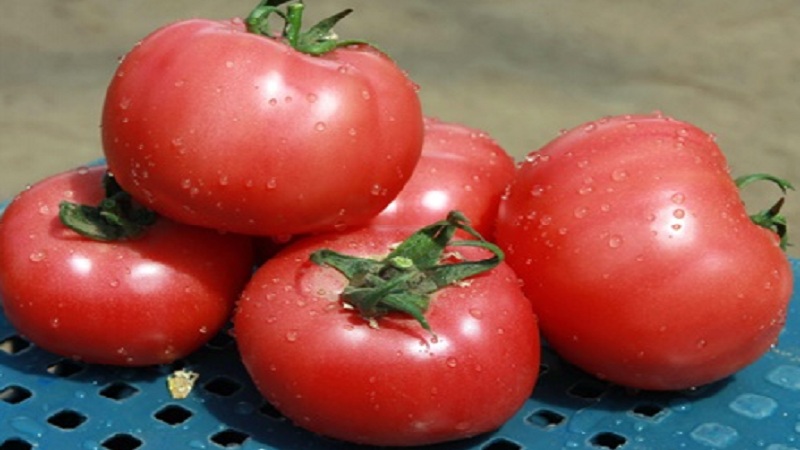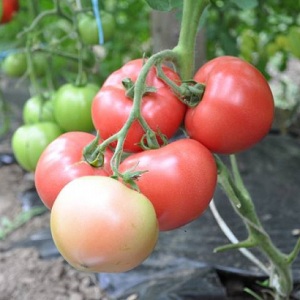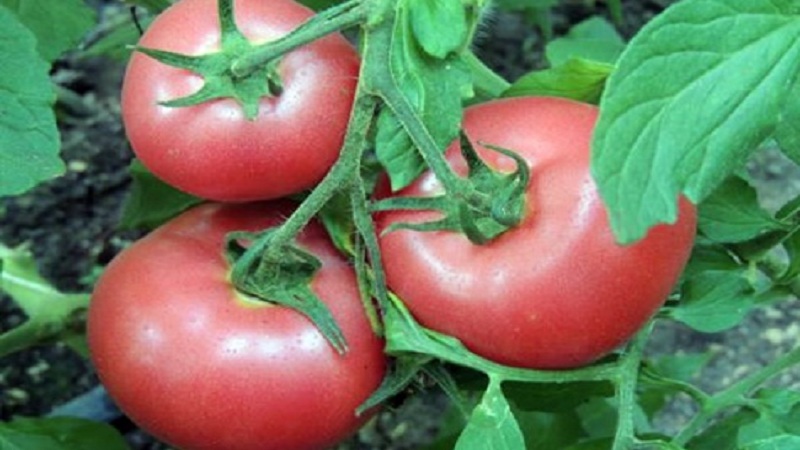Tomato "Pink Claire" - the best solution for the southern regions
Tomatoes Pink Claire F1 is a hybrid specially created for cultivation in regions with hot climates in the open field. Resistance to drought, viral diseases, high yield and excellent taste allow it to remain at the peak of popularity.
In the article we will talk about the features of growing and caring for a hybrid.
The content of the article
Description and characteristics of tomato varieties
The Pink Claire tomatoes were developed by the Israeli company Hazera Genetics Ltd.
Bushes are indeterminate (tall), branched, with a powerful root system. The hybrid is suitable for open field cultivation in the southern regions of the country, greenhouse conditions in the middle zone.
In the photo - Pink Claire tomatoes.

The table shows the distinctive features of the tomato.
| Indicators | Characteristic |
| Weight | 100-120 g |
| The form | Flat-round, slightly ribbed |
| Fruit color | Unripe fruits - light green, ripe - pink |
| Leaves | Medium size, dark green color |
| Inflorescence type | Compact, simple, 5-6 ovaries |
| Pulp | Thick and sweet |
| Taste | Pleasant, balanced |
| Skin | Thin but dense, does not crack when overflowing soil |
| Appointment | The fruits are used for fresh consumption, pickling, pickling, making tomato paste and juice |
| Bushes height | Reaches 2 m |
| Ripening period
|
90-106 days |
| Growing season | 68-70 days after disembarkation of seedlings |
| Yield | 3-7 kg per bush |
| Sustainability | It tolerates drought and temperature fluctuations well, has immunity to tobacco mosaic, verticillosis, fusarium |
| Transportability | Excellent |
Growing regions
Israeli breeders bred the hybrid based on the climatic features of the country, so Pink Claire behaves best in hot and dry climates. Ideal regions for growing within Russia are the Krasnodar Territory, Crimea, Astrakhan Region.
In the areas of the middle lane, the crop is grown only in greenhouse conditions.
Pros and cons
The advantages of the Pink Claire F1 hybrid include:
- high content of niacin, B vitamins;
- high yield;
- resistance to viral diseases;
- pleasant taste and aroma;
- the possibility of transportation over long distances;
- universality of application;
- drought resistance;
- fruits do not decrease in size throughout the entire fruiting period (until the end of October);
- the possibility of cultivation on any type of soil.
Among the disadvantages are:
- necessity pinching, forming a bush and garters;
- the plant requires timely fertilization;
- susceptibility to bacterial lesions.
reference... First generation hybrids (F1) degenerate quickly and are not recommended for growing in subsequent years. Therefore, farmers should renew their seed every year.
How to grow
Pink Claire is unpretentious in maintenance, but in order to get a rich harvest, experienced farmers recommend adhering to the rules of sowing, growing seedlings and planting in the ground.
Seed preparation and sowing

Hybrid seeds do not need a disinfection procedure, but actions aimed at stimulating growth will not be superfluous. The inoculum is soaked in the means "Epin-Extra", "Zircon", "Immunocytofit" for 12 hours. Some gardeners prefer natural remedies - aloe and potato juice, infusion of onion peel and ash, honey. This will help shorten the growing season by 2-3 days and increase germination.
Sowing begins in the third decade of February - the first decade of March. Any container is suitable for planting seeds: plastic pots, containers, cups, tetrapacks from juice or milk. The depth of the container must be at least 5 cm, with holes for the passage of water.
The ideal soil for seedlings is a mixture of black soil with peat and sand in a ratio of 2: 2: 1. Before laying in containers, the soil is loosened and complex fertilizers are applied.
For sowing, the seeds are buried 2 cm into the ground, watered abundantly with warm water, and a plastic wrap is pulled on top.
As soon as shoots appear, the film is removed and the seedlings are taken out on a windowsill with good lighting, or placed under a phytolamp. The optimum temperature is + 20 ... + 25 ° С. Water sparingly, as the soil dries up.
The pick is carried out in large boxes for seedlings after the appearance of 2-3 true leaves. At the same time, a complex feeding is introduced.
Landing rules
Planting seedlings in open soil begins in the third decade of May. A few days before that, fertilize with mullein, chicken droppings.
The wells are poured with hot water, wait for cooling and seedlings are planted. Plants are placed at a distance of 60 cm from each other, since the bushes grow sprawling and require space. Tomatoes feel good on the ground, where zucchini, beans, peas, onions, and garlic grew before.
The row spacing is 70 cm, the type of arrangement of seedlings is staggered. Planting density - 3 bushes per 1 m².
The lower leaves and side stepchildren are removed. The bushes are tied to supports and form two stems.
Bush care and watering

Care activities for Pink Claire tomatoes include weeding, watering, feeding and preventing bacterial diseases of nightshade crops.
Weeding is carried out once a week before watering. Weeds draw moisture and nutrients from the soil, so weeding is a must.
The bushes are watered no more than 2-3 times a week in the evening so that the leaves do not get burned. In rainy weather, watering is stopped and resumed when the heat sets in.
Moderation glaze - the main condition for obtaining delicious tomatoes. An excess of moisture leads to a loss of taste. The pulp becomes too watery and tasteless.
Top dressing
Fertilizers are applied regularly, with an interval of 14 days:
- For the first time, take chicken droppings diluted in 10 liters of water. Ammonium nitrate, superphosphate and potassium chloride are also suitable.
- Second top dressing carried out with 1 liter of mullein infusion mixed with 25 g of superphosphate and two teaspoons of ash.
- The third top dressing includes wood ash (3 tbsp. L.), Superphosphate (25 g) and manganese sulfate (0.5 g).
- Removal of lateral shoots is carried out once every 10-14 days.
reference... If the tomatoes grow poorly, and there are practically no ovaries, the amount of dressings is increased. If the plant grows green mass, but does not form ovaries, fertilization is stopped.
Preventive measures
Rules to help protect tomatoes from attacks by pests and bacteria:
- An excess of nitrogen in the soil provokes the development of pathogenic microflora. Therefore, it is important not to overdo it with fertilization.
- Weeds are a breeding ground for bacteria, aphids, the Colorado potato beetle, whiteflies and slugs. Timely weeding will help avoid the problem.
- The preparations "Zubr" and "Confidor" successfully destroy the Colorado potato beetle and aphids.
- Insecticides in aerosols or treatment with decoctions of chamomile, celandine, yarrow will help get rid of insects.
- The soil before planting seedlings is treated with copper sulfate or potassium permanganate.
- Periodic treatment with "Fitosporin" or a light pink solution of potassium permanganate reduces the risk of phytosporosis infection.
Reviews

Experienced gardeners and novice gardeners speak positively about Pink Claire tomatoes.
Anna, Yeysk: «I have been growing a hybrid for three years in a row and am happy with everything. The bushes are large and branched. The fruit is medium in size, the flesh is sweet and aromatic.Tomatoes are suitable for pickling, pickling and making fresh seasonal salads. "
Vladimir, Dzhankoy: “I've been looking at the seeds of Pink Claire for a long time and decided to plant it last year. I did everything strictly according to the instructions, applied fertilizers and watered on time. As a result, he received a rich harvest. The tomatoes are delicious, juicy and sweet. "
Evgeniy, Krasnodar: “I have been growing Pink Claire tomatoes since the seeds were on sale. Every year I try something new, but I don't change this hybrid. Fruiting is abundant, up to the onset of frost. Tomatoes ripen together, they are practically the same size and are stored for a long time. "
Conclusion
Hybrid Pink Claire F1 has incorporated the best qualities of tomatoes and is practically devoid of disadvantages. Correct sowing, growing seedlings, planting in the ground and caring for bushes helps to get a rich harvest.
Difficulties can arise for inexperienced gardeners, because the plants need regular feeding and moderate watering. But experience only comes with practice.